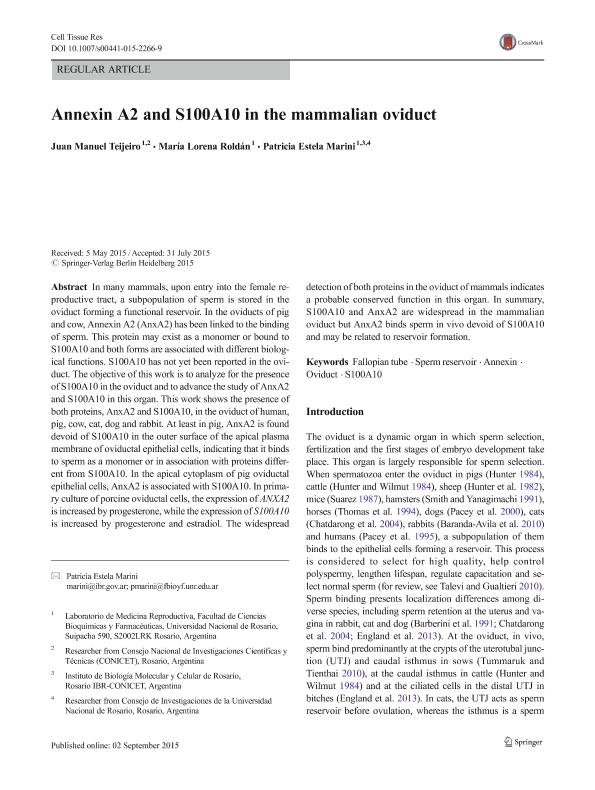Mostrar el registro sencillo del ítem
dc.contributor.author
Teijeiro, Juan Manuel

dc.contributor.author
Roldán, María Lorena

dc.contributor.author
Marini, Patricia Estela
dc.date.available
2017-02-23T20:49:15Z
dc.date.issued
2016-02
dc.identifier.citation
Teijeiro, Juan Manuel; Roldán, María Lorena; Marini, Patricia Estela; Annexin A2 and S100A10 in the mammalian oviduct; Springer Verlag Berlín; Cell And Tissue Research; 363; 2; 2-2016; 567–577
dc.identifier.issn
0302-766X
dc.identifier.uri
http://hdl.handle.net/11336/13342
dc.description.abstract
In many mammals, upon entry into the female reproductive tract, a subpopulation of sperm is stored in the oviduct forming a functional reservoir. In the oviducts of pig and cow, Annexin A2 (AnxA2) has been linked to the binding of sperm. This protein may exist as a monomer or bound to S100A10 and both forms are associated with different biological functions. S100A10 has not yet been reported in the oviduct. The objective of this work is to analyze for the presence of S100A10 in the oviduct and to advance the study of AnxA2 and S100A10 in this organ. This work shows the presence of both proteins, AnxA2 and S100A10, in the oviduct of human, pig, cow, cat, dog and rabbit. At least in pig, AnxA2 is found devoid of S100A10 in the outer surface of the apical plasma membrane of oviductal epithelial cells, indicating that it binds to sperm as a monomer or in association with proteins different from S100A10. In the apical cytoplasm of pig oviductal epithelial cells, AnxA2 is associated with S100A10. In primary culture of porcine oviductal cells, the expression of ANXA2 is increased by progesterone, while the expression of S100A10 is increased by progesterone and estradiol. The widespread detection of both proteins in the oviduct of mammals indicates a probable conserved function in this organ. In summary, S100A10 and AnxA2 are widespread in the mammalian oviduct but AnxA2 binds sperm in vivo devoid of S100A10 and may be related to reservoir formation.
dc.format
application/pdf
dc.language.iso
eng
dc.publisher
Springer Verlag Berlín

dc.rights
info:eu-repo/semantics/openAccess
dc.rights.uri
https://creativecommons.org/licenses/by-nc-sa/2.5/ar/
dc.subject
Fallopian Tube
dc.subject
S100a10
dc.subject
Annexin
dc.subject
Oviduct
dc.subject.classification
Biología Reproductiva

dc.subject.classification
Ciencias Biológicas

dc.subject.classification
CIENCIAS NATURALES Y EXACTAS

dc.title
Annexin A2 and S100A10 in the mammalian oviduct
dc.type
info:eu-repo/semantics/article
dc.type
info:ar-repo/semantics/artículo
dc.type
info:eu-repo/semantics/publishedVersion
dc.date.updated
2017-02-23T13:55:20Z
dc.identifier.eissn
1432-0878
dc.journal.volume
363
dc.journal.number
2
dc.journal.pagination
567–577
dc.journal.pais
Alemania

dc.journal.ciudad
Berlin
dc.description.fil
Fil: Teijeiro, Juan Manuel. Universidad Nacional de Rosario. Facultad de Ciencias Bioquímicas y Farmacéuticas; Argentina. Consejo Nacional de Investigaciones Científicas y Técnicas. Centro Cientifico Tecnológico Rosario; Argentina
dc.description.fil
Fil: Roldán, María Lorena. Universidad Nacional de Rosario. Facultad de Ciencias Bioquímicas y Farmacéuticas; Argentina. Consejo Nacional de Investigaciones Científicas y Técnicas. Centro Cientifico Tecnológico Rosario; Argentina
dc.description.fil
Fil: Marini, Patricia Estela. Universidad Nacional de Rosario. Facultad de Ciencias Bioquímicas y Farmacéuticas; Argentina. Consejo Nacional de Investigaciones Científicas y Técnicas. Centro Científico Tecnológico Rosario. Instituto de Biología Molecular y Celular de Rosario; Argentina
dc.journal.title
Cell And Tissue Research

dc.relation.alternativeid
info:eu-repo/semantics/altIdentifier/doi/http://dx.doi.org/10.1007/s00441-015-2266-9
dc.relation.alternativeid
info:eu-repo/semantics/altIdentifier/url/http://link.springer.com/article/10.1007%2Fs00441-015-2266-9
Archivos asociados
